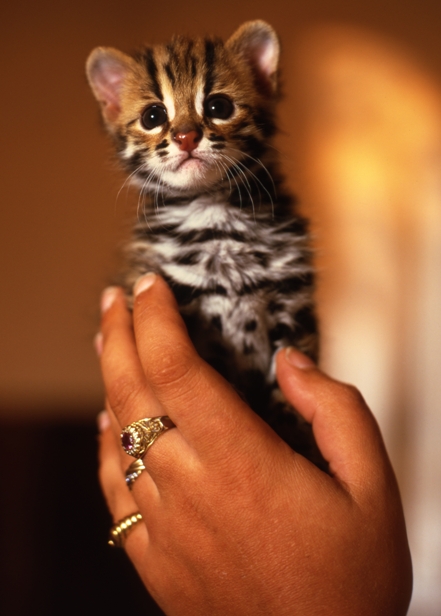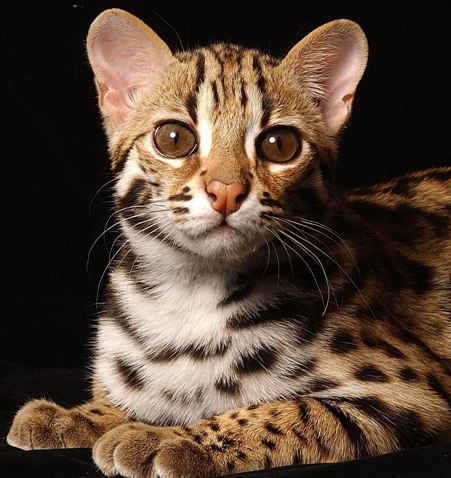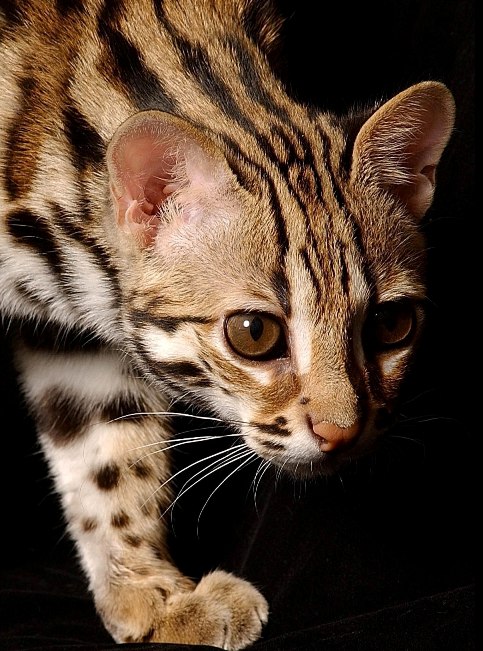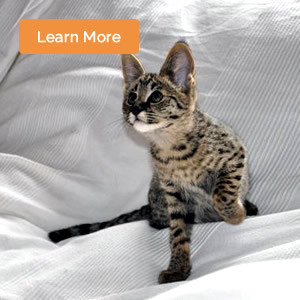The
Ultimate F1 Bengal - Sarez Zeus,
the World’s Most Expensive Cat
By C. Esmond Gay - Sarez Bengals - 2004
In 2003, Sarah and I bred an exceptional F1 Bengal, one who’s probably unique in the world. Sarez Zeus has a staggering 90% wild blood and perfectly encapsulates the wild look of the leopard cat, yet he’s overtly friendly and just as docile as a normal domestic cat. Because of this and his £100,000 price tag, Zeus became an international sensation, mesmerising both the press and the public alike. This article explores some of the complexities of breeding this astonishing Bengal - and what made him the most expensive cat in the world.
 Filial
1s (F1s) are the direct hybrid offspring of the wild leopard cat
and a domestic cat, and they are undisputedly the most
magnificent generation of the Bengal cat. But they are also the most
challenging to breed; so great are the genetic, anatomical and the
financial constraints involved in such hybridisations, that only a
few people in the world have ever succeeded in breeding them.
Filial
1s (F1s) are the direct hybrid offspring of the wild leopard cat
and a domestic cat, and they are undisputedly the most
magnificent generation of the Bengal cat. But they are also the most
challenging to breed; so great are the genetic, anatomical and the
financial constraints involved in such hybridisations, that only a
few people in the world have ever succeeded in breeding them.
Some may be surprised at the prices that my fiancée, Sarah, and I ask for our rarest cats such as Sarez Zeus, and indeed, his £100,000 price was a significant amount of money. But in Britain, F1s have always been costly - anything that’s very rare and beautiful always is. In the early to mid 1990s, we bought three of just four F1 Bengals that were in the country, and we paid very high prices for them; we did so because we wanted them, and that meant we had to pay whatever their owner deemed fit.
Sarah and I have no set prices for any of our kittens - a few we give away to deserving homes, whilst the prices of others are governed by the quality and rarity of particular kittens (colour and generation). And of course, our own huge expenses have to be factored in, including buying exemplary breeding cats, veterinary care, building luxury enclosures, and other running costs of our estate. We work tirelessly to breed the best and the most unique… felines whose beauty and characteristics are awe-inspiring - and we are immensely proud of our accomplishments. A piece of jewellery, an antique vase or even a car number plate, can easily command the same price as Zeus - yet they are all inanimate objects. Yes, they’re all attractive in their own rights, but none can become one’s companion, none can comfort a person nor make them laugh… and none can love. Yet few query their huge price tags…
Whereas, Zeus lives and breathes - he has energy and exuberance for life. He’s affectionate, too… and he loves, because he has feelings and emotions. And he is the perfect embodiment of a leopard, yet with an endearing, human orientated character.
But we did not set his price based on these traits alone; we believe that this cat is also a one off, probably being the only F1 Bengal in the world with such high wild blood. And he is definitely one of the most beautiful pedigree cats ever bred; a “living work of art”. And finally, breeding him and the cats that bore him cost us far more than £100,000!
And so now perhaps, his price is more understandable.
 Breeding any F1 kittens entails many more difficulties and
dangers than normal domestic cat breeding does, and any success is
counterbalanced by equal amounts of heartache; one is dealing with
very sensitive and highly strung wild animals, and with babies that
nature simply hadn’t intended to be. But, at least with 50%
wild blood F1 kittens, one of their parents is fully
domesticated, in the form of their late generation mother. However,
creating Zeus was far more complex because it entailed
breeding F1 babies from very early generation, high wild blood
mothers. We started thinking about it a long time ago…
Breeding any F1 kittens entails many more difficulties and
dangers than normal domestic cat breeding does, and any success is
counterbalanced by equal amounts of heartache; one is dealing with
very sensitive and highly strung wild animals, and with babies that
nature simply hadn’t intended to be. But, at least with 50%
wild blood F1 kittens, one of their parents is fully
domesticated, in the form of their late generation mother. However,
creating Zeus was far more complex because it entailed
breeding F1 babies from very early generation, high wild blood
mothers. We started thinking about it a long time ago…
Over the years, Sarah and I have bought and bred about 15 leopard cats - beautiful ones, with black spots and rosettes upon pale backgrounds, making them ideal for hybridising. And those that aren’t suitable such as our Amur leopard cats (whose coarse coats create poor quality Bengals) and our more endangered subspecies, join our African leopards, ocelots and servals in our Sarez Wild Cat Conservation Programme.
When our leopard cats breed, we hand-rear their cubs and keep them with our domestic cats, but even in this ideal environment, most never hybridise, with just 1 in 15 doing so.
However, in 2000, one of our leopard cats, Sarez Little L., did mate some of his “harem” of Bengal females, becoming the first ever to do so in Britain! Grateful for this miracle, we were not expecting another, but then in 2004, a second leopard cat called Sarez Apollo, hybridised with some of his Bengal females!
Two leopard cats hybridising in one facility is an incredibly rare occurrence and has assured our cats a place in British Bengal history! Sarah and I are overjoyed… these events are our greatest achievements!
 Little L.’s and Apollo’s unrelated
wild blood has vastly improved and strengthened the Bengal’s
quite small gene pool, and the many F1 female offspring they’ve
produced so far, have ensured less inbreeding, healthier cats and
more pedigree lines within this breed.
Little L.’s and Apollo’s unrelated
wild blood has vastly improved and strengthened the Bengal’s
quite small gene pool, and the many F1 female offspring they’ve
produced so far, have ensured less inbreeding, healthier cats and
more pedigree lines within this breed.
But Sarah and I still weren’t satisfied. Most late generation Bengals have stunning coats and rosettes, but few retain the unique wild head and other features of the leopard cat. We wanted to enhance these characteristics in late generations, by breeding down to them using early generation Bengals that have higher than average amounts of wild blood.
In 2000, via very selective breeding from our American lines, Eppie (Sarez Effie) was born (the first F2 snow marble female to be bred in Britain). Not only has she got 25% wild blood and an amazing wild face, but she also carries all of the colours of the Bengal, and we wanted to introduce those genes into our high wild blood F1s.
 Then
we mated Eppie to Little L., and in 2001 she gave birth
to Britain’s first litter of 75% wild blood F1s. The kittens
were breathtaking and so we repeated this mating and in 2002, we bred
another litter which included a female who we called Sarez Pow
Wow. And we felt that she was just what we needed for this
project! And so in early 2003, we mated her to the leopard cat, and
in March of that year a spectacular hybrid Bengal was born, one with
an astonishing 90% wild blood!
Then
we mated Eppie to Little L., and in 2001 she gave birth
to Britain’s first litter of 75% wild blood F1s. The kittens
were breathtaking and so we repeated this mating and in 2002, we bred
another litter which included a female who we called Sarez Pow
Wow. And we felt that she was just what we needed for this
project! And so in early 2003, we mated her to the leopard cat, and
in March of that year a spectacular hybrid Bengal was born, one with
an astonishing 90% wild blood!
Befitting this kittens’ magnificence, we named him Sarez Zeus, after the Greek God (and after his uncle, Pow Wow’s brother). And because we handled him constantly and had only used innately friendly filial Bengals in his ancestry, he grew up with the most placid and charming character.
Due to what Sarah and I had hoped to achieve from this project, naturally we wanted a fertile female, but that wasn’t to be. However, several other F1 females with far higher than average wild blood have been born out of this breeding programme, and they are producing F2s and subsequent generations, all with more defined leopard-like appearances.
This whole process was stressful and draining and it completely dominated our lives for many years; but it was worth it… everyone who set eyes on Zeus has been captivated! The press declared him to be the world’s most expensive cat and over the summer of 2003, he appeared in huge features in multiple worldwide newspapers and magazines, and also 7 times on British TV, plus many more in 35 other countries! And, ignoring all the cameras and strangers around him, he behaved impeccably on all, playing with my fiancée and young daughter, Kitten Gay, in front of vast audiences. And whilst some of the news features debated his price, others his heritage and his astonishing good looks, all wrote about his gentle and amicable personality. What a superb advocate for the Bengal cat! Zeus proved to millions that as a high wild blood F1 can be trustworthy and loving even when in a stressful situation, then a late generation is surely as docile as a rabbit!
 And our other Bengals have also become brilliant ambassadors
for the breed, starring on about 35 TV programmes and in
over 100 publications and they’ve even
advertised Armani, Versace and Cavalli haute couture in
the likes of Vogue Pelle, Tatler and Country Life. This
entices an eclectic mix of celebrities from Lord Jeffrey Archer
to Jonathan Ross to buy our kittens, drawing yet more good
publicity to the breed. Even scientists such as Dr. Andrew Kitchener,
curator of the National Museums of Scotland, study our
work with F1s in the hope of duplicating it for conservation
purposes.
And our other Bengals have also become brilliant ambassadors
for the breed, starring on about 35 TV programmes and in
over 100 publications and they’ve even
advertised Armani, Versace and Cavalli haute couture in
the likes of Vogue Pelle, Tatler and Country Life. This
entices an eclectic mix of celebrities from Lord Jeffrey Archer
to Jonathan Ross to buy our kittens, drawing yet more good
publicity to the breed. Even scientists such as Dr. Andrew Kitchener,
curator of the National Museums of Scotland, study our
work with F1s in the hope of duplicating it for conservation
purposes.
Yet some people in the British Bengal fancy have been hostile about the early generations, making broad and sweeping statements such as: “F1s, F2s and F3s do not exist as Bengal cats…”, and that they: “…are not part of the Bengal breed in any way…” But the true experts on the Bengal offer very different opinions. The following is part of a 1996 letter from Jean Mill, the pre-eminent founder of the breed, to Cat World magazine:
I am the originator of this breed of domestic cat and have been involved from 1980 with their acceptance into various cat registries both in the USA and abroad.
The first three generations of Bengals are classified as “foundation Bengals”. They are somewhat shy, retiring cats, that are no more vicious or aggressive than Siamese. In the USA, Bengals of all generations are accepted by our Department of Agriculture and California Fish and Game, and do not need a license.
Last fall, I visited Esmond Gay’s cattery in England and met all his cats including his F1s Baby Gem, Leopardette and Occie. It is most regrettable that the well justified fear of wolf hybrids has been fanned to include a fear of our tiny, purring early generation Bengal cats by people who have never even see one before!
Crossed with a domestic cat, the resulting mixed-species kittens are independent and aloof - but are no more dangerous than traditional family cats.
Yours,
Jean Mill
It is an ignorant minority who disagree with such an expert; people who don’t understand the importance of filial generations, simply because they cannot breed them themselves.
Some also say that early generations should never be kept as pets. Again, having lived with so many, Sarah and I beg to differ. We never sell the fertile F1 females we breed, but our well socialised, sterile males do make wonderful pets to the right people - families who are willing to adapt their lives to suit the needs of the cats. However, we are cautious when re-homing them and don’t sell to impulse buyers, nor to those we suspect may not provide a stable, permanent home for the whole of the kitten’s life. We also ensure:
The prospective new homes must have some experience in small wild cats.
They build an indoor/outdoor enclosure so the cat has fresh air and human contact.
The home must have a DWA licence, meaning the council will monitor the cat as well.
 During
our vigorous interview process, we explain what these cats are, what
the prospective owner should expect from them, and how they will
behave as they get older. We watch how the visitors interact with the
kittens and we question them about their own routines, ensuring that
at least one member of the family will be predominantly at home so
that the cat won’t be left alone for long. And we enquire why
they want an early generation rather than a later generation kitten,
as we don’t sell cats as status symbols!
During
our vigorous interview process, we explain what these cats are, what
the prospective owner should expect from them, and how they will
behave as they get older. We watch how the visitors interact with the
kittens and we question them about their own routines, ensuring that
at least one member of the family will be predominantly at home so
that the cat won’t be left alone for long. And we enquire why
they want an early generation rather than a later generation kitten,
as we don’t sell cats as status symbols!
Fortunately, due to the popularity of our kittens, we are never forced to sell them due to lack of space or because they are getting older etc., and with many people chasing just a few kittens, this allows us to pick and choose the perfect home for our babies. And to this day, we’ve never made a mistake, despite the number of F1s that we’ve re-homed.
And as for Zeus, well, he is as popular today as he was in 2003, as one can see on the internet. His beauty still captivates the public, so much so that his image adorns many products ranging from posters to car sun shades. I'm not sure whether to feel upset that his image is being used so extensively without our permission, or to feel proud that others deem our creation to be so stunning that they use his photos to sell their merchandise.
All Bengals are remarkable and precious; their unique heritage has bestowed many wondrous traits and features upon them - ones that no other pedigree cat can ever attain. They truly came from the jungle - and will always retain remnants of the wild…
And the importance of filial Bengals is insurmountable - they are the quintessential generations of this breed - without them, Bengals would simply be “another spotted cat”.
C. Esmond Gay
Sarez Bengals
Copyright 2004 C. Esmond Gay
Dedicated to Sarez Zeus
Retirement Addition (2008)
Sarah and I achieved a phenomenal amount during the 11 years that we bred Bengals and many of our accomplishments are still unsurpassed. We obsessively chased every one of our goals and ambitions and didn’t stop until we had succeeded. And everything we did was meticulous and done to perfectionist standards.
However, this entailed working up to 18 hours a day, 7 days a week, and with few breaks or holidays. In hindsight, we did too much too fast because the enormous stress that we put ourselves under, plus looking after hundreds of animals almost single-handedly, took its toll on us mentally, emotionally and physically. By 2004, Sarah and I were suffering from severe exhaustion and so reluctantly, we retired. We hoped to lead a quieter life in Latin America, living and working with their endangered cats.
Our larger wild felines went to wildlife parks, our rescued animals went to sanctuaries and private homes, whilst many of our Bengals and leopard cats went to Pauline and Frank Turnock of Gayzette Bengals - they look after and nurture our cats, and are expanding the breeding programme that we worked so hard to create.
I stay in regular contact with Pauline and Frank and offer them my support and advice on the Bengal and wild cats. I follow their achievements, and behind the scenes, I am there for them and for the beautiful cats that we once so proudly owned.
To Sarah and me, our cats were more than just pets or breeding animals - they were our family. And within the articles I wrote, my deeply emotional descriptions of them and how they influenced our lives, portrays just how powerfully I love them; and so naturally, I feel terrible loss and miss them tremendously. However, I am grateful for the 11 wonderful years that they graced our home, and for the honour and privilege of being able to share part of my life with them… and for the amazing memories that they’ve left me with.
C. Esmond Gay










